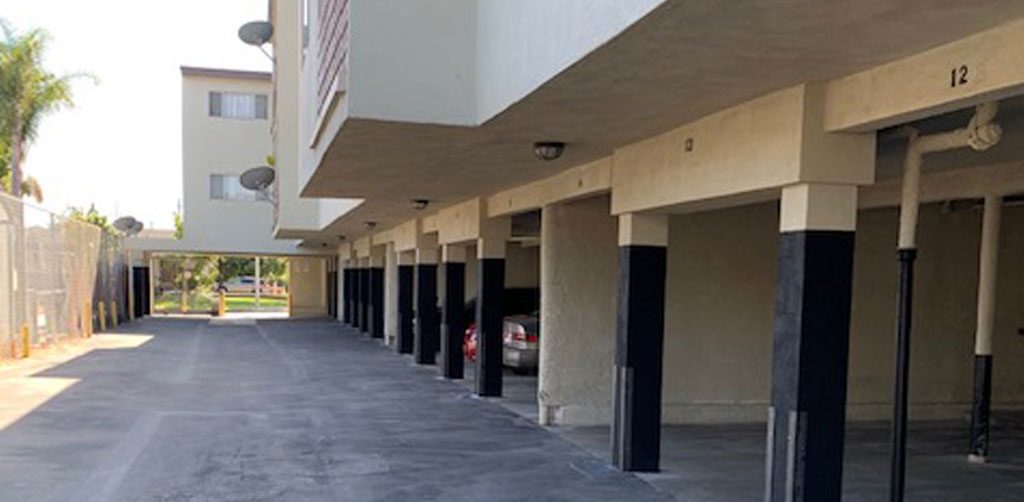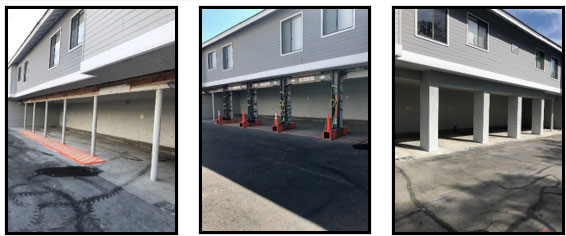How Soft-Story Retrofit Methods Strengthen Your Building

Soft-story buildings — those with open ground floors or large storefronts — are among the most vulnerable structures during earthquakes. When the first floor lacks the rigidity to support the upper levels during lateral shaking, the result can be catastrophic: leaning, cracking, or even collapse.
Earthquake data and engineering studies underscore the urgency of seismic retrofitting. According to a FEMA-supported study published in Structure Magazine, commercial buildings that followed FEMA P-807 designs reduced their collapse risk to below 20%. At the same time, unretrofitted structures remained at a significantly higher risk.
This guide explains the most common soft-story retrofit construction methods and how each one strengthens your building to perform more safely in seismic events.
What Is a Soft-Story Building?
A soft-story building is a multi-story structure with a flexible or open ground floor and stiffer upper floors. Common examples include:
- Apartment buildings with tuck-under parking
- Mixed-use buildings with open retail fronts
- Office buildings with large lobbies or glass façades
- Parking-level or warehouse structures with wide bays
Because the lower story lacks sufficient bracing or walls, it cannot properly transfer the sideways forces created during an earthquake. Retrofitting adds strength and stiffness so the entire structure moves as one, reducing the risk of collapse.
Soft-story buildings are particularly common in California cities with high population growth, extensive mid-20th-century wood-frame construction, and many large-opening ground floors (such as those with tuck-under parking or street-level retail space).
Historical factors such as lower seismic-code requirements in earlier decades and the need to maximize ground-floor flexibility contributed to their prevalence.
Across California, thousands of soft-story commercial and multi-unit residential buildings are being strengthened under city ordinances. Los Angeles alone has identified roughly 12,400 buildings under its seismic retrofit program, with about 69% already complete—representing more than $1.3 billion in construction investment.
This large-scale effort reflects a regional commitment to protecting occupants, assets, and business continuity.
Why Soft-Story Retrofits Are Needed
In every seismic retrofit project, engineers aim to restore two critical qualities often missing in soft-story designs:
- Lateral stiffness — the building’s ability to resist side-to-side (and vertical) movement.
- Lateral strength — the building’s ability to transfer those forces safely to the foundation.
Without both, the ground floor acts as a hinge during seismic motion, creating extreme stress where the upper and lower stories meet. Retrofitting addresses this imbalance and helps protect tenants, property value, and business continuity.
According to FEMA P-807-1 (2023), targeted retrofits for soft/weak/open-front wood-frame buildings—often referred to as SWOF structures—can dramatically reduce collapse risk and bring older buildings closer to modern performance standards.
Regulatory and Compliance Snapshot
Across the western U.S., retrofit requirements now extend to many types of income-producing buildings:
- City of Burbank: The Soft-Story Seismic Retrofit Ordinance, effective January 2025, requires evaluation and strengthening of multi-unit and commercial structures with open ground floors.
- City of San José: Approved its soft-story retrofit program in 2024, adding multi-family and commercial buildings to its priority list.
- Los Angeles and San Francisco: Maintain long-standing ordinances covering both mixed-use and residential-over-retail buildings constructed before 1978.
These policies signal a lasting shift toward proactive risk management for property portfolios. Acting early helps owners control costs, meet deadlines, and avoid compliance bottlenecks.
Common Soft-Story Retrofit Methods
Each soft-story building is unique, and the retrofit method depends on its design, materials, and structural weaknesses. Below are three of the most common construction techniques used to strengthen these buildings.
Concrete Column Footing
Purpose: Strengthen vertical load paths and stabilize open areas.
Footing Prep Rebar Install Pour Back Finished Footing
Concrete column footings usually use grade beams so the footings do not move. This creates a stronger foundation for columns supporting upper stories. The process typically includes excavation, rebar installation, and concrete pour-back. Once complete, the new footing increases load-bearing capacity and helps prevent uplift or footing movement during seismic shaking.
When it’s used:
- Buildings with exposed or undersized support columns
- Parking-level structures with minimal shear walls
- Projects needing reinforcement without major redesigns
This method is efficient and allows many properties to remain operational during construction. In advanced applications, engineers may specify reinforced concrete jacketing or fiber-reinforced polymer (FRP) wrapping to improve ductility and energy absorption—especially useful when operations limit access for larger foundation work.
Moment Frame Installation
Purpose: Add flexible strength to open layouts.
Prep Install Finished Frame
A moment frame is one of the most commonly used retrofit methods because it allows parking spaces and open areas to remain unaffected. It consists of a steel frame structure designed to resist lateral movement while keeping ground-level spaces—such as storefronts or parking areas—fully functional. The frame is securely anchored to the existing foundation and upper-floor connections, creating a continuous load path from top to bottom.
When it’s used:
- Retail or mixed-use buildings with wide openings
- Apartment complexes where open parking must remain accessible
- Properties where owners want seismic resilience without sacrificing design or usability
Moment frames act like flexible skeletons, absorbing and redistributing seismic forces so the building sways safely rather than collapsing. FEMA P-807 and P-807-1 recommend steel moment frames for soft-story structures because they balance strength and flexibility, preserving open layouts while improving performance.
Shear Wall Reconstruction
Purpose: Increase rigidity through reinforced wall systems.
Plywood Lath Stucco Finished
A shear wall resists lateral forces by transferring them evenly to the foundation. In soft-story retrofits, contractors may install new plywood shear walls or reinforce existing walls with steel or concrete. The process often involves framing, applying structural sheathing, lath, and a final stucco finish to match the building’s appearance.
When it’s used:
- Multi-family buildings with large windows or garage openings
- Structures with limited column spacing or weak wall panels
- Projects requiring additional rigidity in targeted zones
Shear-wall retrofits are especially effective for stabilizing wood-frame buildings common throughout California and the western U.S.
Engineering studies show a 7:1 benefit-to-cost ratio for new shear walls and roughly 4:1 for steel moment frames—demonstrating that seismic strengthening provides both safety and financial return.
Engineers may also incorporate diagonal steel bracing or FRP panel overlays to enhance stiffness without extensive reconstruction, an approach often chosen for occupied or operational buildings to minimize disruption.
At a Glance: Which Method Fits Your Building?
| Retrofit Method | Best For | Key Benefit |
| Concrete Column Footing | Buildings with open parking or weak vertical supports | Improves foundation strength and load transfer |
| Moment Frame Installation | Wide openings or retail façades | Adds lateral strength while preserving open space |
| Shear Wall Reconstruction | Wood frame structures or large window spans | Increases rigidity and lateral resistance |
Choosing the Right Method for Strengthening Your Soft-Story Building
No two buildings share the same seismic vulnerabilities. The appropriate retrofit method depends on your property’s age, layout, and existing structural system.
FEMA P-807-1 (2023) provides evaluation criteria and retrofit design options for soft/weak/open-front structures—the same framework Saunders applies when coordinating with engineers to meet code and lender expectations.
Saunders Seismic partners with engineers to assess each structure and recommend solutions that balance safety, cost, and operational needs. Whether your building requires one method or a combination, the goal is always the same — to make it stronger, safer, and code-compliant.
The Saunders Retrofit Approach
A soft-story seismic retrofit doesn’t have to disrupt your business or your tenants. Saunders simplifies the process from start to finish:
- Transparent consultations to help you understand your retrofit options.
- Collaborative engineering coordination to design efficient, code-compliant solutions.
- In-house crews who complete projects with minimal tenant disruption.
- Clear communication from planning through final inspection.
With decades of experience and thousands of completed retrofits across California, Oregon, Washington, Nevada, and Utah, Saunders Seismic is the trusted solutions partner for commercial and multi-family property owners.
Every seismic retrofit starts with understanding. Let’s make your building stronger — and safer — together.
Contact Saunders Seismic for a free, no-pressure consultation today.



